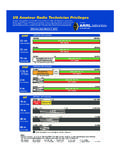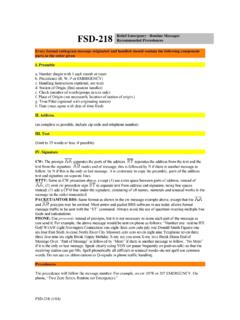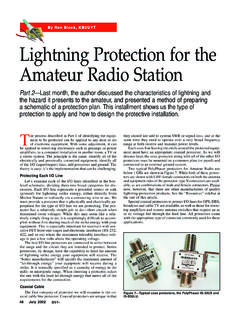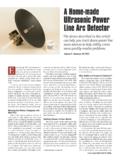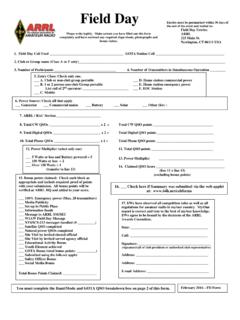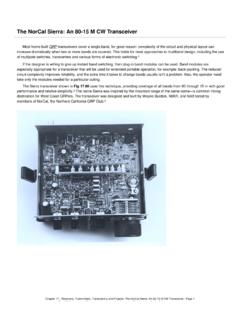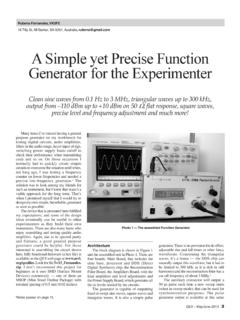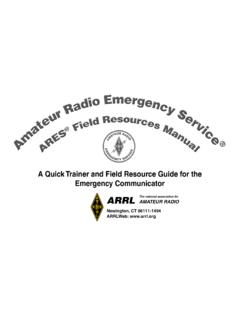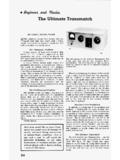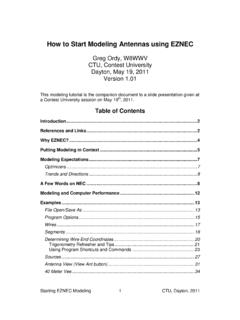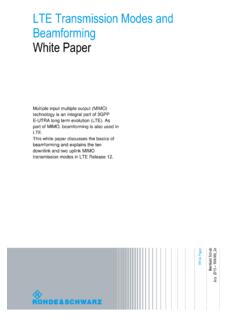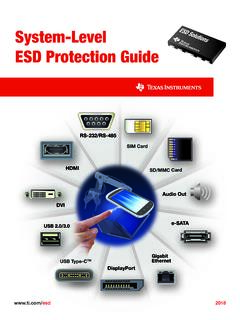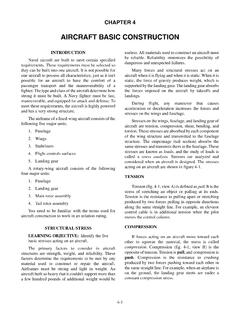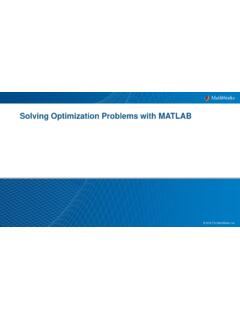Transcription of Why an Antenna Radiates - ARRL
1 Why an Antenna Radiates You don't have to know how an Antenna works to use one, but getting a handle on this subject can deepen your understanding of radio. Here's a searching look at the mysterious process by which our antennas hurl energy from Here to There. By Kenneth Macleish, W7TX QST November 1992 If antennas didn't radiate, we might be well advised to dispose of our ham gear and take up another hobby. Fortunately, they do radiate. Our purpose here is to explore the basic principles underlying this wonderful and little-understood phenomenon. Before starting, let's try a simple test to see how much you already know about antennas. Don't peek at the answers1 until you have answered all the questions! 1. In a center-fed, half-wave dipole, electrons surge back and forth from one side of the Antenna to the other. True ___ False ___ 2. It is possible for a perfect insulator to radiate.
2 True ___ False ___ 3. Unlike ohmic resistance, "radiation resistance" has significance only at the feed point of an Antenna or Antenna system. True ___ False ___ 4. The ground around a transmitting Antenna Radiates . True ___ False ___ If you got all the answers right, you probably know more than the writer, and you have permission to skip the rest of this article. An Imaginary Experiment Take a pithball about the size of a marble between your thumb and forefinger. If you don't know what a pithball is, or can't find one, a hunk of plastic foam or a ping pong ball will be fine. For lack of a better name we will refer to any of these articles as a pithball. Rub the pithball on your carpet to give it a good electrical charge. Now wave the pithball back and forth in the air over a six-inch distance as fast as you can. The pithball is sending out electromagnetic waves!
3 Let's say you are achieving a rate of 10 cycles of motion per second. If you have placed in the corner of the room a sufficiently sensitive megameter-wave receiver, it will detect a signal when tuned to a frequency of 10 hertz, or to a wavelength of 30 million meters. If you could vibrate your hand fast enough you might even be able to carry on radio communication in this fashion! We will continue this experiment shortly. Meanwhile let's take a look at what goes on inside an Antenna . Put Your Antenna Under a Microscope Now, admittedly the average Antenna doesn't contain any pithballs. But it does contain hordes of minute, lightweight, electrically charged particles called electrons. Many of these are so-called free electrons that have broken loose from their parent copper or aluminum atoms and are able to travel more or less freely through the spaces between atoms, under the influence of any electric fields that may be present.
4 The free electrons behave in many ways like tiny pithbaIls. We know that an electric current in a conductor is simply a mass migration of free electrons. If the current is alternating, as in an Antenna , the free electrons in a given locality move back and forth in unison. Evidently, then, any individual electron moves to and fro around an average position, like the pithball in our experiment. Let's see how far and how fast this electron might travel. Consider an Antenna made of #12 copper wire and operating at MHz. Each free electron near the surface of the wire is executing million cycles of motion per second. Knowing the number of free electrons per cubic inch of copper, the electric charge on each, and the depth of RF penetration into the wire (the skin depth), we can calculate the peak speed of an electron at a place where the RMS Antenna current is, say, one ampere.
5 The result comes out to be less than half an inch per second. At that rate the electron doesn't move very far during each half cycle of vibration: its peak-to-peak travel is no more than a hundred-millionth of an inch. In the eyes of an electron this distance is quite respectable, being tens of thousands of times its own diameter. The answer to question 1 above, though, is clearly "False." Not one electron makes it through the feed system from one side of the Antenna to the other. We can compute the electron's deceleration and acceleration, which are greatest when the electron is coming to a stop and then starting up in the other direction. At an Antenna current of one ampere, these quantities reach more than 50,000 gs! And an accelerating or decelerating charged body, be it an electron or a pithball, is a source of electromagnetic radiation. A pithball is a pretty good insulator, and so, presumably, is an electron.
6 So the answer to question 2 is "True": a perfect insulator can radiate. Let's return to our imaginary experiment. This time, instead of waving a pithball at 10 hertz, we'll pretend to vibrate a single electron at radio frequency2 and examine the resulting fields. Fields of a Vibrating Electron The detailed structure of an electron is unknown, but for our purposes it doesn't matter; we can assume that our electron is a little round ball with an electrical charge distributed uniformly over its surface. We determine the fields by solving Maxwell's equations3 at all distances from the electron, right down to its surface. This analysis is not an exercise for the faint-hearted. We'll skip the details and concentrate here on the results. Fig 1 -- Always present around a charged particle, the coulomb field plays a vital role in energy radiation. The Coulomb Field Grasping the electron in, say, a tiny pair of tweezers, let's start by holding it still.
7 After a while the only field present will be a stationary electric field that points outward4 in all directions from the electron. The field lines take the form illustrated in Fig 1 for both positive and negative charges. This is called the coulomb field. It is always present, regardless of whether the electron is in motion. We'll find later that the coulomb field plays a vital role in the operation of antennas. With vibratory motion, two new fields make their appearance. The Magnetic Field A moving electron constitutes a current, and a current is always surrounded by a magnetic field. As if hitchhiking, point the thumb of your right hand in the direction of the electron's motion; then your curled fingers represent the circular lines of the magnetic field around the electron. Point your thumb in the opposite direction and you see that the magnetic field reverses, so a vibrating electron gives rise to an alternating magnetic field.
8 At the electron's surface, the magnetic field is almost exactly in phase with the electron's speed, but as we move away, the phase of the magnetic field begins to lag. Out to a radius of 1/6 wavelength, the phase lag is small. Beyond this radius, the lag starts to increase at a more rapid rate and soon settles at 360 degrees per wavelength of distance. Fig 2 -- The radiation field of an electron vibrating as MHz. Each broken line represents a wave crest. The Dynamic Electric Field The second new field is an electric field that results from the electron's acceleration. Because of its dynamic origin -- in contrast to the electrostatic nature of the coulomb field -- we'll call this field the dynamic electric field. It's useful to regard the dynamic electric field as the sum of two separate fields, one of which is in phase with the magnetic field and the other 90 degrees out of phase.
9 We will call the in-phase component the radiation field and the out-of-phase component the induction field. It is the radiation field that carries energy from an Antenna into the surrounding universe. Fig 2 shows an area the size of a football field in which a lone electron, greatly magnified, is being vibrated at MHz. The figure is a snapshot of the electron's radiation field taken at an instant when the electron is at the center of its travel and moving to the right, as indicated by an arrow. The curved arrows show the direction and strength of the radiation field. The dashed circles represent spherical wavecrests on which the field is at a local maximum. As we go outward from a wavecrest, the field decreases to zero, then reverses and rises again to the next wavecrest. Like ripples in a cosmic pond, these spherical waves are expanding outward at the speed of light, 300 million meters per second.
10 At any one point, the radiation and induction fields vary as sine-wave functions of time. About 1/6 wavelength away from the electron (actually 1/[2p ] wavelength), in a direction at right angles to the line of motion, the two fields are equal in amplitude. As we move farther away, the induction field falls off so much more rapidly than the radiation field that we soon have essentially nothing but the radiation field. Inside a vacuum-dielectric coaxial transmission line carrying power in one direction, the ratio of the electric to the magnetic field is equal to 377 ohms. In our pure radiation field, which carries power in the same manner even though there are no physical conductors present, this ratio is likewise equal to 377 ohms-a value that is sometimes called the characteristic impedance of space. Fig 3 -- The electric field of an electron that was accelerated recently.
